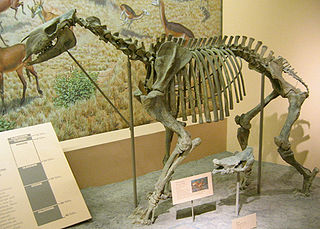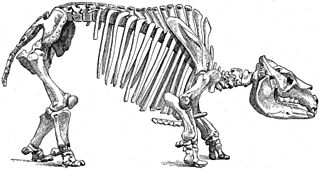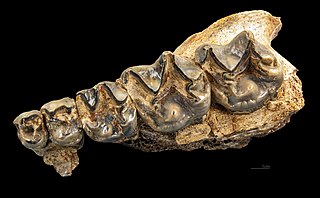
Ancylopoda is a group of browsing, herbivorous, mammals in the Perissodactyla that show long, curved and cleft claws. Morphological evidence indicates the Ancylopoda diverged from the tapirs, rhinoceroses and horses (Euperissodactyla) after the Brontotheria; however, earlier authorities such as Osborn sometimes considered the Ancylopoda to be outside Perissodactyla or, as was popular more recently, to be related to Brontotheriidae.

Odd-toed ungulates, mammals which constitute the taxonomic order Perissodactyla, are animals—ungulates—that have reduced the weight-bearing toes to three or one of the five original toes. The nonweight-bearing toes are either present, absent, vestigial, or positioned posteriorly. By contrast, the even-toed ungulates bear most of their weight equally on four or two of the five toes: their third and fourth toes. Another difference between the two is that odd-toed ungulates digest plant cellulose in their intestines, rather than in one or more stomach chambers as even-toed ungulates, with the exception of Suina, do.

Moropus is an extinct genus of large perissodactyl mammal in the chalicothere family. They were endemic to North America during the Miocene from ~20.4–13.6 Mya, existing for approximately 6.8 million years. Moropus belonged to the schizotheriine subfamily of chalicotheres, and has the best fossil record of any member of this group; numbers of individuals, including complete skeletons, have been found.

Chalicotherioidea is an extinct superfamily of clawed perissodactyls that lived from the early Eocene to the early Pleistocene subepochs. Based on the fossil record they emerged and thrived largely in Eurasia, although specimens have been found in both Africa and North America. They were likely browsers that fed mainly on leaves, twigs, and other nonresistant vegetation. Many of the contained genera had derived specializations of the forelimb and manus that allowed the claws to be used as hooks for browsing and to be kept off of the ground while walking. Chalicotheres lived primarily in forested areas. Size sexual dimorphism and morphological structures such as the domed skulls of Tylocephalonyx suggest agonistic behaviour in some sort of social setting. They are related to modern day horses, rhinoceroses, and tapirs, as well as the extinct brontotheres.

Notoungulata is an extinct order of mammalian ungulates that inhabited South America from the early Paleocene to the Holocene, living from approximately 61 million to 11,000 years ago. Notoungulates were morphologically diverse, with forms resembling animals as disparate as rabbits and rhinoceroses. Notoungulata are the largest group of South American native ungulates, with over 150 genera in 14 families having been described, divided into two major subgroupings, Typotheria and Toxodontia. Notoungulates first diversified during the Eocene. Their diversity declined during the Late Neogene, with only the large toxodontids persisting until the end of the Pleistocene, perishing as part of the Quaternary extinction event among with most other large mammals in the Americas. Collagen analysis suggests that notoungulates are closely related to litopterns, another group of South American ungulates, and their closest living relatives being perissodactyls, including rhinoceroses, tapirs and equines. However their relationships to other South American ungulates are uncertain. Several groups of notoungulates separately evolved ever-growing cheek teeth.

Chalicotherium is a genus of extinct odd-toed ungulates of the order Perissodactyla and family Chalicotheriidae. The genus is known from Europe and Asia, from the Middle Miocene to Late Miocene.

Mesaxonia also known by its equivalents Panperissodactyla and Perissodactylamorpha is a clade of ungulates containing all ungulates more closely related to living Perissodactyla than to Artiodactyla. Groups thought to belong to this clade include Anthracobunia known from the Paleogene of the Indian subcontinent, as well as the South American native ungulate groups Litopterna and Notoungulata. Other South American native ungulate groups also possibly belong to the clade, but their placement is uncertain. The enigmatic aquatic Desmostylia have also been suggested to be related to perissodactyls in some studies, though others recover them as more closely related to Afrotheria. The Northern Hemisphere "condylarth" group Phenacodontidae has been placed as closely related to perissodactyls in some studies, though others recover it as unrelated.

Ancylotherium is an extinct genus of the family Chalicotheriidae, subfamily Schizotheriinae, endemic to Europe, Asia, and Africa during the Late Miocene-Early Pleistocene, existing for approximately 7.2 million years.

The John Day Formation is a series of rock strata exposed in the Picture Gorge district of the John Day River basin and elsewhere in north-central Oregon in the United States. The Picture Gorge exposure lies east of the Blue Mountain uplift, which cuts southwest–northeast through the Horse Heaven mining district northeast of Madras. Aside from the Picture Gorge district, which defines the type, the formation is visible on the surface in two other areas: another exposure is in the Warm Springs district west of the uplift, between it and the Cascade Range, and the third is along the south side of the Ochoco Mountains. All three exposures, consisting mainly of tuffaceous sediments and pyroclastic rock rich in silica, lie unconformably between the older rocks of the Clarno Formation below and Columbia River basalts above.

Pseudhipparion is an extinct genus of three-toed horse endemic to North America during the Miocene. They were herding animals whose diet consisted of C3 plants. Fossils found in Georgia and Florida indicate that it was a lightweight horse, weighing up to 90 pounds. In 2005, fossils were unearthed in Oklahoma. Seven species of Pseudhipparion are known from the fossil record which were very small, following the trend of Bergmann's rule.
Tylocephalonyx is an extinct chalicothere from the Miocene of North America.

Borissiakia is an extinct genus of chalicothere, a group of herbivorous, odd-toed ungulate (perissodactyl) mammals, that lived during the late Oligocene in Kazakhstan. They had claws that were likely used in a hook-like manner to pull down branches, suggesting they lived as bipedal browsers.
Chemositia is an extinct genus of chalicothere, a group of herbivorous, odd-toed ungulate (perissodactyl) mammals. They lived in Africa, and had claws that were likely used in a hook-like manner to pull down branches, suggesting they lived as bipedal browsers.

Oodectes is an extinct paraphyletic genus of placental mammals from clade Carnivoraformes, that lived in North America from early to middle Eocene.
Xinyuictis is an extinct genus of placental mammals from clade Carnivoraformes, that lived in Asia from early to late Eocene.

Schizotheriines are one of the two subfamilies of the extinct family Chalicotheriidae, a group of herbivorous odd-toed ungulate (perissodactyl) mammals that lived from the Eocene to the Pleistoscene. The other clade is the Chalicotheriinae. Both clades had claws rather than hooves on their front feet, an adaptation understood as related to feeding. Schizotheriines also had claws on their hind feet. The fossils of both groups are found in environments that had trees and shrubs. While chalicotheriines developed very derived body forms, schizotheriines remained basically similar in shape to other perissodactyls such as horses and tapirs. Like most forest-dwelling ungulates, they had long necks and forelimbs longer than their hindlimbs. Schizotheriines had longer, higher-crowned cheek teeth than chalicotheriines, which indicates they typically fed on tougher vegetation. The sediments where their fossils are found show they also lived in a wider range of environments, from moist forests to drier woodland or savannah-like environments with trees. Perhaps for this reason, they became more widely distributed than chalicotheriines. Though chalicotheres likely evolved in Asia, schizotheriine fossils are also found in Africa and North America, which they reached by the Bering land bridge. The best-known schizotheriine genus is Moropus. The last survivor of the group was traditionally thought to be Nestoritherium, but it was found to actually be a member of Chalicotheriinae.
Metaschizotherium is an extinct genus that belongs to the family Chalicotheriidae, which was a group of herbivorous perissodactyl ("odd-toed") mammals. Though found primarily in Europe, fragmentary remains suggest that their range extended into Asia.

Chalicotheriines are one of the two subfamilies of the extinct family Chalicotheriidae, a group of herbivorous, odd-toed ungulate (perissodactyl) mammals that lived from the Eocene to the Pleistocene. The other subfamily is the Schizotheriinae. Chalcotheriines evolved unique characteristics for ungulates, with very long forelimbs, short hindlimbs, and a relatively gorilla-like physique, including knuckle-walking on their flexible forelimbs, which bore long curved claws. Members of this subfamily possessed some of the longest forelimbs and shortest hindlimbs in relation to each other out of all extinct animals. Analysis of dental wear implies that most chalicotheriines fed on seeds and fruit. Their claws were likely used in a hook-like manner to pull down branches, suggesting they lived as bipedal browsers.

Phenacodontidae is an extinct family of large herbivorous mammals traditionally placed in the “wastebasket taxon” Condylarthra, which may instead represent early-stage perissodactyls. They lived in the Paleocene and Eocene epochs and their fossil remains have been found in North America and Europe.
Cambaytherium is an extinct genus of placental mammals in the family Cambaytheriidae whose fossils were found in an open pit coal mine located in Gujarat, India. The mine was a treasure trove full of teeth and bones, over 200 of which were identified as belonging to Cambaytherium thewissi. The fossils were dated to the Early Eocene, 54.5 million years ago, making them slightly younger than the oldest known fossils belonging to the order Perissodactyla.















